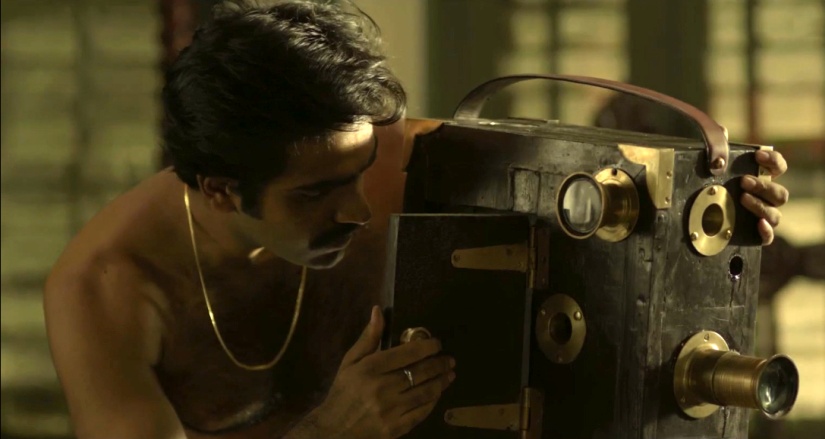Hiralal: The Uncredited Role, in the making for quite some time, is just Arun Roy’s third film in a period of over ten years. The film tells the tragic, story of Hiralal Sen, an early pioneer of Indian cinema, who came out with about 40 films between 1899 and 1913. Most of these from 1901-1904 were scenes from some of the plays at the Classic Theatre in Calcutta and featured in the intervals of the shows. Sadly, nothing remains of Sen’s creations as all his life’s work was destroyed in a major fire in 1917, shortly before his death. The biopic is an ode to Sen’s pioneering contribution to the growth of the Motion Picture Industry in India.
The film looks at how the young Hiralal (Kinjal Nanda), a still photographer, shifts his interest to the moving picture after he sees a reel of moving pictures in a tent theatre set up by Stevenson, an Englishman. Totally taken in by the new medium, he decides to buy a movie camera – a huge contraption that he carries with his helping hand, Kanu (Bidyut Das), from place to place to film and screen film reels he makes on religious places like Tarakeshwar, a pilgrim city and others. These images, shot by Sen, would mark some of the earliest short moving pictures in Indian cinema history and lay the foundation for a career in motion pictures for Sen as he would found the Royal Bioscope Company along with his brother, Motilal, and make a career out of recording moving pictures.
Obviously, with our lack of archiving and recording of history, very little is known about Sen’s life. In order to capture the spirit of Sen, Roy’s and Sounava Bose’s script and dialogue include a number fictional and dramatic elements in an attempt to create an engaging film. To bring conflict into the drama, another early cinema pioneer, JF Madan, has been portrayed as the ‘villain’ or the antagonist pitted against Sen. From exhibiting films in a bioscope tent to building the first permanent cinema theatre in India, from owning a chain of theaters to exhibition of foreign films, from producing films locally to creating the first Indian film star, Patience Cooper, Madan was an entrepreneur in the truest sense of the word. This, when he entered the world of cinema in 1902 after already having become a big success in the world of theatre and dabbling in importing liquor, foods and pharmaceutical products, besides dealing in insurance and real estate as well. Not only does Madan try to cut down Sen and his film business in any way he can with the diabolical lawyer, Tarini, but according to the film, they are suspected of engineering the fire in the godown that held all the reels of every film Sen ever made, destroying, in the process, not just a significant slice of history but its maker, forever.
The film’s movement from place to place along with Hiralal as he carries his huge camera is smooth, even and seamless. The most outstanding feature of the film is when Hiralal suddenly discovers Surendranath Banerjee delivering a very fiery speech from the Town Hall protesting the Partition of Bengal. Sen, on the spot, decides to shoot the footage thus making Indian cinema’s first ‘political’ newsreel documentary. The reels are later seized from his home by the British police never to be seen again. Sen also made what are regarded as the first ever advertising films in India, on Jabakusum Hair Oil and Edward’s Tonic. The first advertising film shot around Jabakusum, its owner CK Sen overwhelmed with this new technological invention, works well specially because of Sankar Chakraborty’s convincing performance as the thrilled-to-bits CK Sen.
Roy takes care to avoid putting a halo around Sen and fleshes him out with his own set of flaws. The relationship between Classic Theatre’s arrogant and very rude owner Amrita Nath Dutta (Arna Mukhopadhyay) leads to the fame and success of both Dutta and Sen till it breaks up when we discover that Sen is equally to blame and is no less arrogant and conceited than the much more successful Dutta.
Roy smartly uses actors without baggage or fixed images, drawing most of them from the stage. So we see them as characters in the film rather than the actors performing their roles. Kinjal Nanda and Arna Mukhopadhyay as Hiralal and Amrita, respectively, have performed brilliantly. Special mention must be made of Kinjal’s stripping himself of 25 kilos of his body weight within weeks to make his cancer-ridden image appear realistic. Kharaj Mukherjee is excellent at Girish Ghosh, the legend of Bengali theatre but this episode could have been clipped as it has no direct relevance to the main story. The dramatic episode showing a drunk and saddened Hiralal coming into Kusum Kumari’s (Tannistha Biswas) home, the actress-dancer-mistress of Amarendra Nath Dutta and pouring his heart out to her is an extravagance for the kind of film Hiralal Sen is. Anushka Chakraborty’s realization of Hiralal’s wife, Hemangini, who grows through the film and backs her husband like a solid wall through thick and thin, is very good.
Gopi Bhagat’s cinematography effectively uses shades of yellows, siennas, browns to invest the film with the mood of the period that flashes back by nearly a century. The ProductionDesign captures the time period aptly with the huge camera, a reminder of bygone days, the tent theatres, the dance numbers from plays captured on camera to be shown in the pauses in the play and the loud dance costumes in bizarre colours countered with the domestic scenes in Sen’s home in Calcutta and Benares. The music is very low key and subtle that does not disturb the narrative yet invests it with a lyricism of its own.
Overall, Hiralal: The Uncredited Role is a relevant film giving a forgotten pioneer of Indian cinema his due.
Bengali, Drama, Biopic, Color


